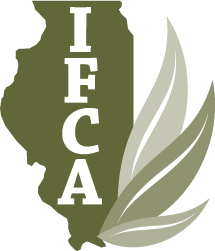Corn and soybean crops at mid-season, 2019
The 2019 Illinois corn crop reached 50% planted during the first week of June, more than a month later than the average of the past five years. The soybean crop reached 50% planted a few days later than corn, and more than three weeks later than the average of the past five years. May rainfall was above normal over most of Illinois, and June brought near-normal rainfall over much of the state. Still, the late planting coupled with too much or too little rainfall after planting produced July crop condition ratings of only about 40% good + excellent for both crops, compared to an average of some 70% over the past three years.
Corn
While corn crop condition ratings haven’t improved over the past month, the warm temperatures and good sunlight have resulted in good growth of the crop in most fields, except in low, wet spots. Leaf color of the crop has also improved, as soils have dried enough to allow the roots to reach N from both fertilizer and from mineralization. This has helped the crop plants and crop canopy to recover some from the rough start.
The 20% of the corn crop planted between mid-April and mid-May has reached or completed pollination in most fields, in line with growing degree day accumulations: at Champaign, about 1,400 GDDs accumulated between May 15 and July 15, enough to get a 110-day RM hybrid to, or close to, pollination. That number is only about 1,140 at DeKalb, where little corn was planted by mid-May anyway. With little disease or insect pressure and with dark green leaves, most of the fields that have reached or finished pollination should end up with high kernel counts, which means high yield potential.
Most of the Illinois corn crop was planted at the end of May or during the first half of June, and little of this late-planted crop has reached pollination: only 19% of the Illinois crop pollinated by July 14, which is about the same percentage of the crop that was planted by mid-May. June 1 through July 15 GDD accumulations totaled about 930 at DeKalb, and about 1,060 at both Champaign and Mt. Vernon, in southern Illinois. At current GDD accumulation rates of 25 to 30 GDD per day (this will decrease some with the cooler weather next week), corn planted in early June will reach begin to pollination towards the end of next week. Corn planted after June 10 will probably not pollinate until early August, although early hybrids—we can estimate about 10-11 fewer GDD for each day earlier in RM, or about 2 days earlier for each 5-day drop in RM—may pollinate by the end of July. Objective yield estimates, which use kernel counts, will be difficult to make early this year, with so little of the crop through pollination by the end of July.
Click Here to read more.
Corn
While corn crop condition ratings haven’t improved over the past month, the warm temperatures and good sunlight have resulted in good growth of the crop in most fields, except in low, wet spots. Leaf color of the crop has also improved, as soils have dried enough to allow the roots to reach N from both fertilizer and from mineralization. This has helped the crop plants and crop canopy to recover some from the rough start.
The 20% of the corn crop planted between mid-April and mid-May has reached or completed pollination in most fields, in line with growing degree day accumulations: at Champaign, about 1,400 GDDs accumulated between May 15 and July 15, enough to get a 110-day RM hybrid to, or close to, pollination. That number is only about 1,140 at DeKalb, where little corn was planted by mid-May anyway. With little disease or insect pressure and with dark green leaves, most of the fields that have reached or finished pollination should end up with high kernel counts, which means high yield potential.
Most of the Illinois corn crop was planted at the end of May or during the first half of June, and little of this late-planted crop has reached pollination: only 19% of the Illinois crop pollinated by July 14, which is about the same percentage of the crop that was planted by mid-May. June 1 through July 15 GDD accumulations totaled about 930 at DeKalb, and about 1,060 at both Champaign and Mt. Vernon, in southern Illinois. At current GDD accumulation rates of 25 to 30 GDD per day (this will decrease some with the cooler weather next week), corn planted in early June will reach begin to pollination towards the end of next week. Corn planted after June 10 will probably not pollinate until early August, although early hybrids—we can estimate about 10-11 fewer GDD for each day earlier in RM, or about 2 days earlier for each 5-day drop in RM—may pollinate by the end of July. Objective yield estimates, which use kernel counts, will be difficult to make early this year, with so little of the crop through pollination by the end of July.
Click Here to read more.
